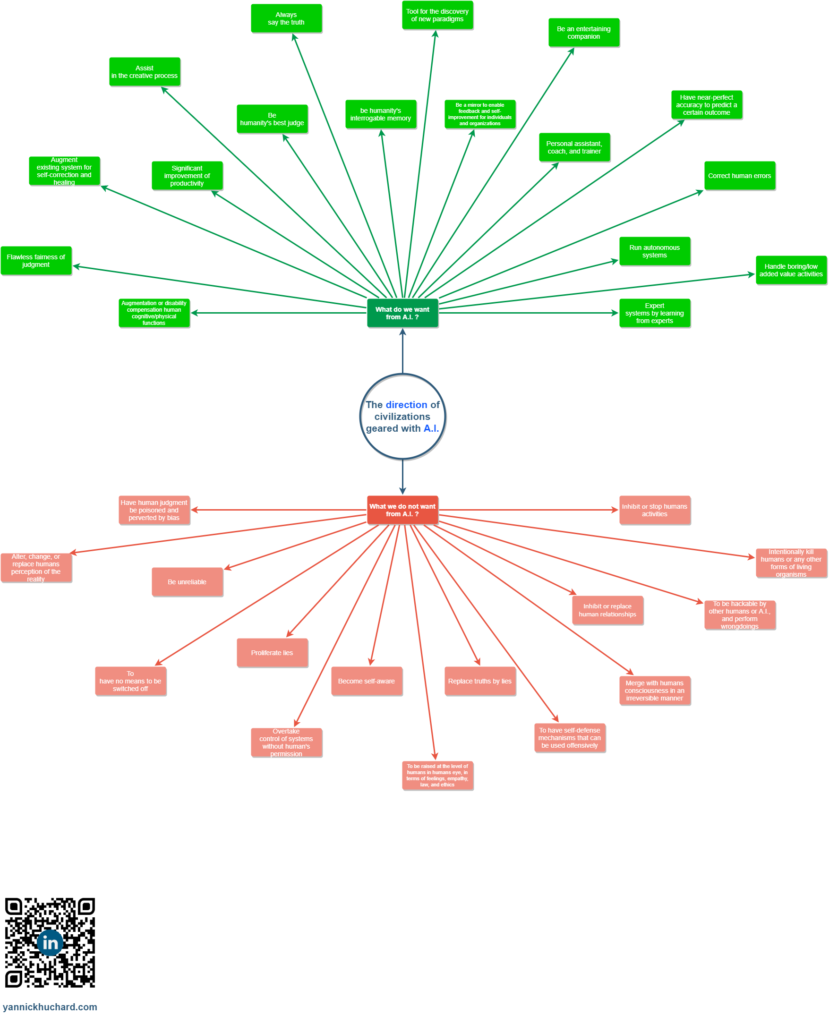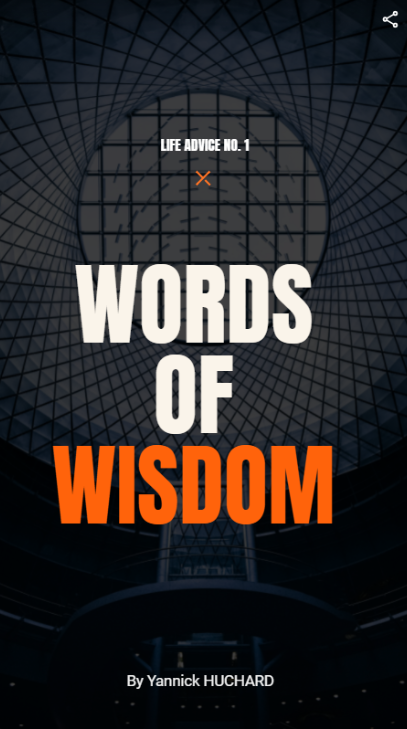“There is no dumb question, only dumb answers”
This is what my teacher told me when I was in primary school. This simple yet powerful sentence cancelled my fear of looking stupid when asking questions whenever I felt the need to.
Today, in my leadership position, I regularly ask questions for various reasons. The primary motive is that leading within the realm of excellence requires understanding the situation and bridging it with objectives you must reach. Then, it is about delivering a simple message, built on the why, how and what so that your peers understand the mission and have all the elements to make it happen. Everything happens for a reason, my responsibility lies in exposing the reason, taking decisions, and consequently triggering actions.
The second motive is that I need to understand the depth of systems and I simply LOVE acquiring knowledge. This fuels my motivation. It is like filling an endless toolbox that helps me to invent, build, compose, and innovate. I guess it is the scientist and the engineer parts in me. And I am still curious about life as a 4-year-old kid. All innovation starts with the same question: ‘How do we solve this problem?’ This question launches startups and is the mother of all technological advancements.
The sentence I use the most is « I don’t understand, can you explain, please? ». it is about being aware there are a variety of things to discover, then there are many different points of view, outmatched by ways of thinking. What fascinates me the most is when people share their experiences. I am also conscious that my interlocutor’s sentences and my very own understanding are two sides of the conversation. The point is, that it’s not always smooth communication.
It is about finding the right channel and angle.
It is about finding the right tempo and timing.
In this situation, I use the almighty Question Mark, a weapon created eons ago as powerful as Thoth’s Caduceus.
“I am just a child who has never grown up. I keep asking these ‘how’ and ‘why’ questions. Occasionally, I find an answer “
Stephen Hawking
Yes, the question mark, a single-character sign, possesses this power. Just like a math unary operator, it is a linguistic operator that empowers you with multiple abilities. And here they are:
Expanding knowledge by the means of asking a question. The brain has the habit of filling the gaps of ignorance using analytical skills, an association of concepts, and similarities. While it works more often than one thinks, it is inaccurate, even misleading sometimes. By gaining more awareness about this innate mechanism, we tend to cover gaps by following the foundational maxim, “If you don’t know, ask”. The Bible said it in another way “Ask, and thou shalt receive.”.
Assert or confirm a statement by seeking a true or false answer, increasing the force of your internal knowledge system. English has this nice reverse interrogation formulation where the auxiliary and the pronoun are inverted. For example: “The dog was cleaned, wasn’t it?” or “The Internet is the most powerful network, isn’t it?”. Another technique consists of using “be” as a tool for opening the field of possibilities for answers, meaning one can respond by confirming or infirming with a piece of complementary information. For example: “Was it Descartes who once said ‘I think, therefore I am’?”. Here, I tend to see the question mark as an invitation to conclude a contract of trust: my understanding is acknowledged; therefore, I trust your words.
It forces action through suggestions. When one says “You are going to do it, aren’t you?”, you give that push that will trigger the intended cascade of events.
You can use a question mark to invite someone to do something or join you. For instance, “If you have time, would you like to have dinner tonight?”. This is a gentle way to request someone to do something of their own will.
It demonstrates your genuine interest in what someone is saying or thinking. For example, when someone asks a question during a debate, it constitutes a trigger indicating a need to be filled or a bond to be made. It is also an expression of interest in what she or he could say. In this regard, it is an invitation to participate in the idea exchange.
Did you know your questions are so valuable they have built business behemoths?
In 1997, Larry Page and Sergey Brin founded Google. Interestingly, the original name was “Googol,” but, due to a mistake, the company was registered as “Google.” A googol is a number with a hundred zeros.
Fast forward to today, and Google is the undisputed king of search engines, holding a 91% market share. There are 85 billion queries per month on Google in 2024.
Notably, the second most popular website is YouTube, which also relies on finding the right video based on your searches and attention. Google, YouTube, Instagram, Pinterest, X, and TikTok all share a common revenue source: advertising. Google popularized keyword bidding for ads: the more directly a keyword is associated with a common search, the more expensive it becomes. That’s how your questions acquire monetary value and become the fuel of social media super-algorithms.
Now that we are talking about money, it reminds me of the book “Rich Dad, Poor Dad” by Robert Kiyosaki. There is a striking example of how the question “How can I buy this house” instead of the affirmation “I cannot buy this house”, shifts the way your brain operates. Asking yourself the right question, rather than making an affirmation, triggers a thinking process that induces self-motivation. Facts are static until they get shaken; questions are the beginning of a story. They represent the spark.
While teaching my children how to use the Internet safely, I have rediscovered the most powerful effect of the question mark: the power to plant the seed of an idea with a drop of water, and the new beginning of the dark ages. It is the rise of click baits and misleading titles in online newspapers that makes me wonder “Why do people click?”, “Why do I want to click?”, “What is the true intention of this article? ». By turning an idea into a question, there is no assertion. This is a state where neither the truth nor the lie is told but induced. You express your opinion in the most open way possible, and you activate the inner functions of the human psyche. A mind will naturally try to fill gaps whenever information is missing to either decide, lead one toward a goal, or fill a knowledge hole. This process is just an innate mechanism of the brain. You should know that a lot of content is now automatically generated by artificial intelligence, designed to exploit these psychological mechanisms for traffic and revenue or to trap users with malware, which is more harmful. The intent is to hack your mental system. One must be aware of this and should always ask the question « What is the true intent of the authors ». Then, what’s the difference between convincing and manipulating?
If you have yet to see the movie Inception by Christopher Nolan, I highly suggest watching it.
By asking a question, you can present your idea gently and say, « I may be wrong, and I am open to suggestions. Let me tell you what you think ». On the positive side, when the intent is pure, it is a form of expression that is polite and smooth. It reminds me of the precepts of “Nonviolent Communication” by Marshall Rosenberg. On the negative side, you can exploit people’s minds and practice the art of manipulation.
Questions create cues, which are powerful mechanisms to awaken your mind and provoke a reminder to act or recall a memory. I have discovered that expert project managers use this technique, either willingly or subliminally, to prompt actions and increase the likelihood that the flow of work and cadence stays high among the various actors involved in the project. Sometimes, great achievements are born from seemingly insignificant pushes.
A well-architected set of questions creates a frame of thought. This frame acts as a guide, helping you to build reasoning. This reasoning leads to other questions and decisions. Ultimately, it creates an outcome that you can use, like a design, a plan, or an analysis, learned, or taught. This set is even more powerful than a task list, even though it requires more effort. I used this technique for building the AMASE Product and Service Architecture Canvas.
Beyond questions lies the dynamics of knowledge flows.
For those familiar with hermetic principles, you’ll recognize the profound power of questions. I view questions as channels of feminine energy – not in terms of gender or sex, but as conduits drawing information, knowledge, and wisdom from one place to another. This energy is then transformed into action, thoughts, decisions, or stored as knowledge.
Consequently, speaking the truth and sharing what you know (outside of storytelling contexts) is a principle one should adhere to. To do otherwise risks poisoning minds, as discussed earlier.
Interestingly, as a question receiver, you’re invited to answer or act: essentially, to give energy. Have you ever been in a job interview? That long series of interrogations is exhausting. With this in mind, you’ll understand why the pace and sequence of questioning, followed by active listening, enhances the quality of an interview or conversation.
To push this reflection further, I see wisdom as a higher state of energy that one can maintain effortlessly. Wisdom is a dense ball of useful energy – the accumulated and structured knowledge and know-how – from which one can tap and maximize benefits. The wise can passively nurture and grow this body of wisdom like a supernova. This is the path of the Sage.
TED Talk‘s motto is “Ideas worth spreading.” We’ve discussed how to uncover such ideas, but an equally important question is: how do we spread specific pieces of knowledge that are worth sharing?
Once again, questions are tools. I know an executive who employs this tool skillfully to align their staff and spotlight individuals who deserve recognition, especially in front of other executives. Questions spread easily like ideas because they open mental gates and reposition worldviews by offering new perspectives. The expression “Hmm, I never thought about that” often originates from a well-posed question!
The 2nd dimension of questioning
“I don’t want to be a didactic voice. I like to ask more questions than I answer, just to get people thinking and to make it safe to access art”
Hannah Gadsby
People use a secondary dimension as we speak to fuel the question marks’ superpower: the tone. The tone gives more depth, and more information, to communication.
A tone that ends with a high pitch will induce emptiness, which is to be filled with knowledge
A tone ending with a low pitch will induce completeness almost filled with willpower
It can be warm and calm so that your audience has fertile ground for inner reflection and trigger a deep-thinking process
Another way is to use a more seductive tone to induce something without saying it. Like the previous superpower, it is to be used with genuine intention because it makes people believe something. Therefore, it is better to be true; otherwise, you are just abusing someone’s dreams or weaknesses.
Finally, one can use a more threatening tone. The purpose of this is to express a « one last chance ». Your counterpart is put in the corner, and she or he will have to make a choice, for which the result may be costly if it is the wrong choice. As the former heavyweight boxing champion, Mike Tyson, said: « Everybody has a plan until he gets punched in the face ».
I realized that, like laughter, tone signifies the same meaning in most languages. Perhaps the truth lies here: sound imbued with emotion is the universal language, don’t you think?
To wrap up, the Art of Questioning can be synthesized into five key aspects:
- The art of quickly and clearly mapping the realms of the unknown and unclear, while making their boundaries tangible for everyone.
- The art of unearthing the truth.
- The art of carving an idea to absolute clarity.
- The art of guiding, influencing, and (unfortunately) manipulating.
- The art of mastering the flow of knowledge.
Can we consider questioning a science? I asked myself this and discovered there is, indeed, a field of research dedicated to ‘questioning,’ as well as a nascent discipline named ‘Questionology.’.
With that, I’ll leave you with one final piece of advice: With practice and curiosity, awareness leads to wisdom. Use the question mark’s power wisely.
🫡
Yannick HUCHARD


